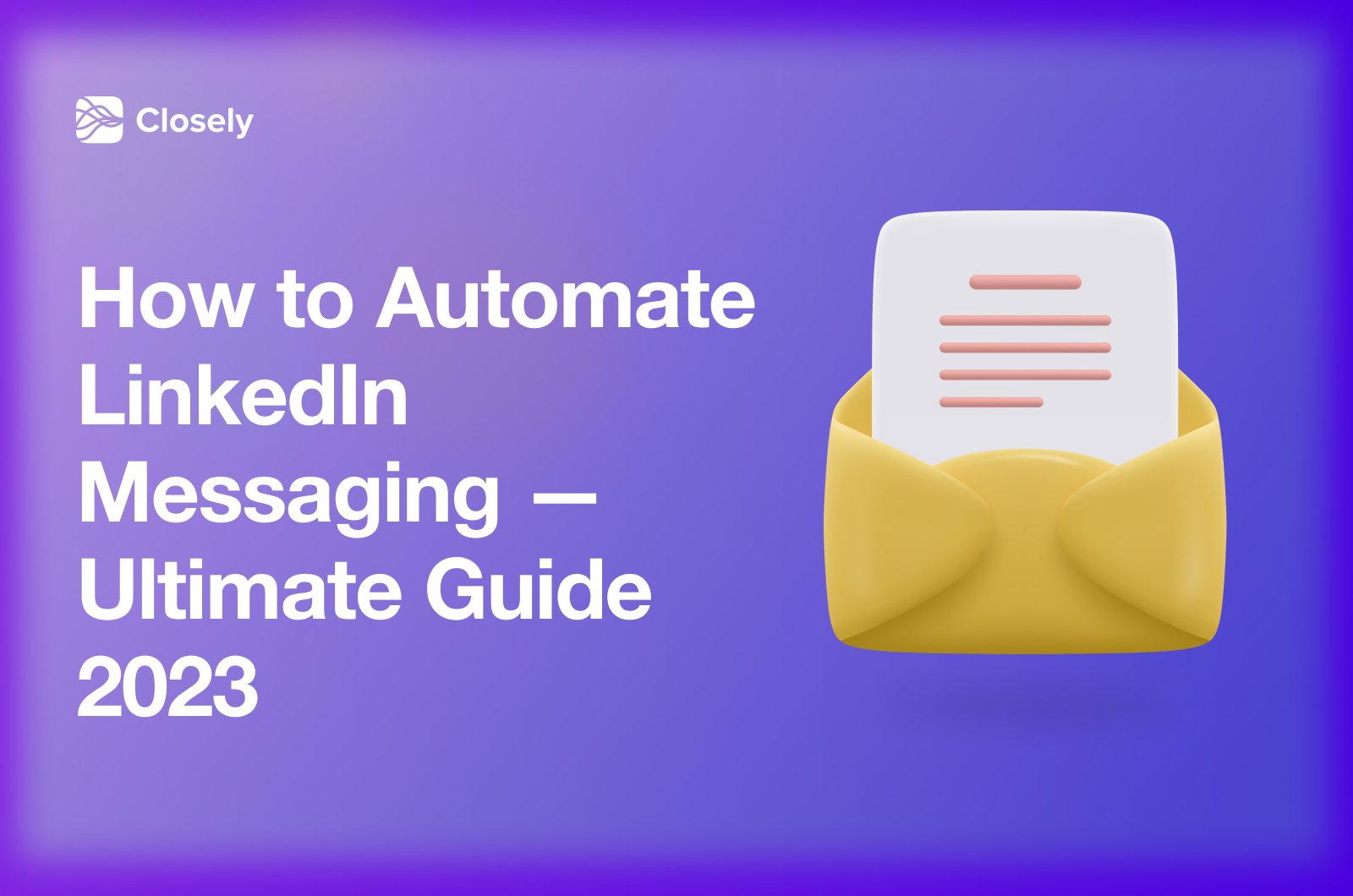Whether you’re a startup or a well-established company, — if you offer a B2B product to the market, the time will come when you’ll get to the point where you’ll search for new ways of scaling. To stop means to stagnate.
In this article, we will share some tips on how to automate LinkedIn messaging in the most convenient and hurdle-free way, and shed light on how LinkedIn automation can fuel your sales in 2023 (by not only automating LinkedIn messaging, but providing you with whole lots of other heart-warming and mind-blowing solutions).

This comprehensive guide will explain how LinkedIn automation helps in scaling fast, and how to start using that very tool of your choice, avoiding all the possible pitfalls.
LinkedIn for sales – still unbeatable
It’s 2023, and some things never change: singing karaoke and calling ex when you’re hammered are two worst ideas, and LinkedIn is still #1 channel for B2B lead generation.
Depending on the specifics of your product and your business goals, you may use marketing or outbound sales to find and engage your customers. Most of the time, sales reps of the B2B field use social sales to find, acquire, nurture, and retain customers, if outbound sales is the primary channel of lead generation. LinkedIn is the #1 channel for this purpose. It’s simply built around the idea that everyone can come, nurture needed business connections, and sell products, eventually. Simple as that.
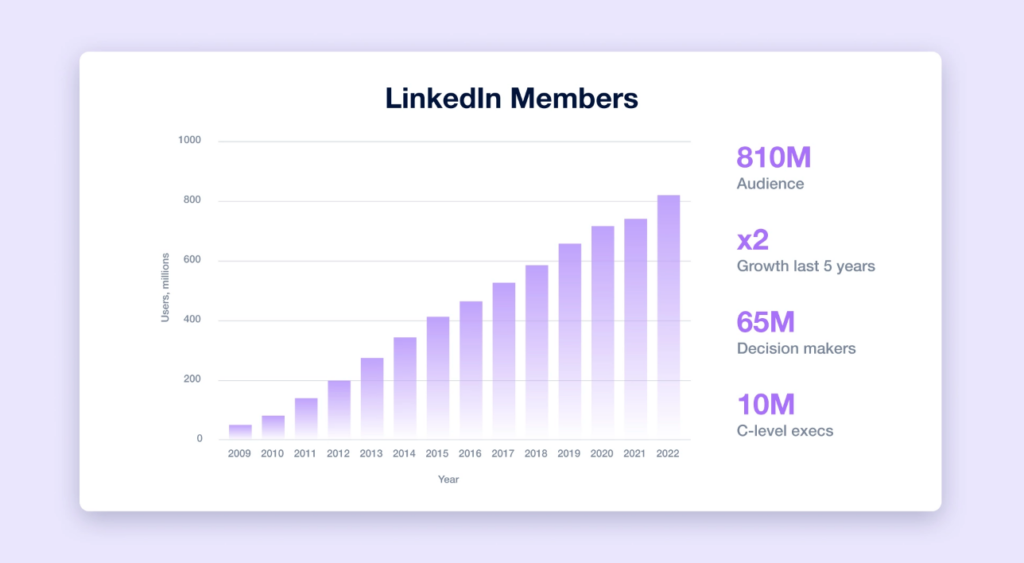
Social sales is the way to sell things to people, pretending like you never planned to sell.
LinkedIn is the place where you can find, engage and build connections — with high-quality audiences that can also be qualified as potential high-dollar retained customers.
LinkedIn prospecting is a science. You need to know how to build your outreach strategy in a way that will let you engage thousands of leads and convert them into customers, non-stop, gradually spending less time and money on your outreach over time. All this while being non-intrusive, and staying on a light note.
Most sales teams are aware that LinkedIn automation helps to get rid of everyday mundane actions — those that eat up lots of time. Building lead lists, sending connection requests, reaching out to each prospect in the list, follow-uping them, and of course, keeping tabs on every interaction with prospects.
LinkedIn automation tools are actually designed to take care of all the mentioned steps: they can build lead lists for you, send connection requests automatically, auto message after connecting, and gather all the analytical data in one place.
Here is what’s new. Did you know that automation tools can also affect the quality of your outreach? They can improve your targeting, messaging, and even teach you how to craft the perfect message.
What is a LinkedIn automation tool?
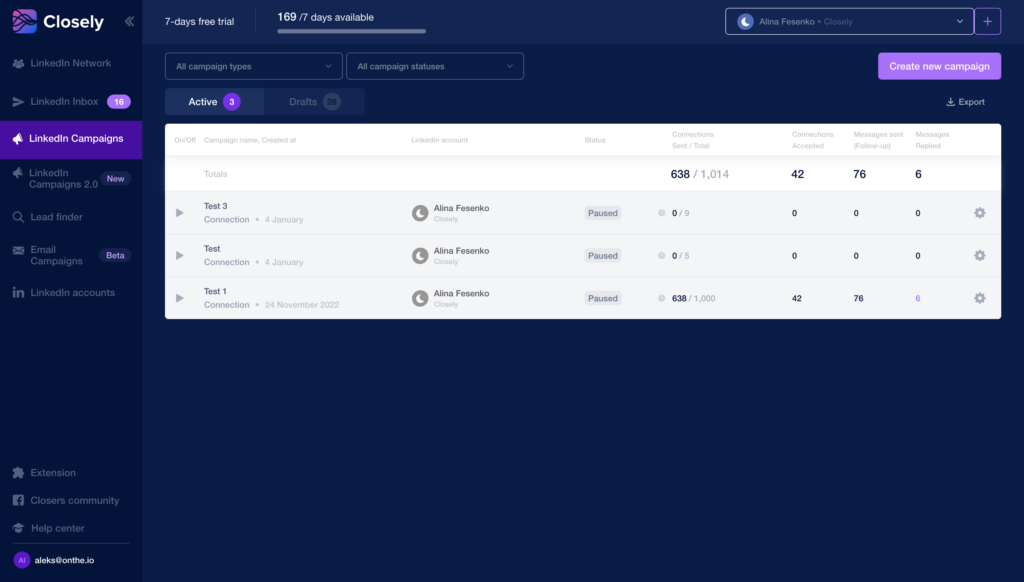
This is a piece of software (subscription-based usually) that comes with an array of features for automating the whole lot of LinkedIn leadgen tasks for you. Usually, you pay for using it monthly. You whole sales team can use it and work within it, staying on the same page with each other. Automation tools’ primary task is to send mass messages to LinkedIn users, letting you expand your LinkedIn network and scale faster.
Actually, today using LinkedIn for lead generation without incorporating a smart automation solution equals futile business: your competitors will stay ahead of you if you don’t manage to keep up with the tough pace of B2B business landscape. That’s an axiom.

The thing is — some tools go far beyond simple message automation. Here is a full list of advanced LinkedIn automation’s capabilities.
Full list of advanced LinkedIn automation’s features
Here is a full list of LinkedIn automation’s capabilities.
1.LinkedIn automation tools automate LinkedIn Messaging
First and foremost, LinkedIn automation tools automate LinkedIn prospecting. You can build a connection campaign in it: this means the tool will send connection requests to your prospects, and then, after a connection request is accepted, it will follow-up your prospects with messages that you’ve built inside the tool.
Once the prospect replies to any of the messages from the sequence, the campaign stops running. Their replies go to the embedded Inbox — your sales reps can catch on and start communication with the prospect.
As you can see, the primary purpose of a LinkedIn automation tool (it’s sometimes also called sender bot) is to fully automate lead generation routine tasks, leaving your hands full with only those tasks that require your creativity — like closing deals.
2. LinkedIn automation tools improve your targeting

You wouldn’t expect this, but some tools like Closely provide numerous sales intelligence solutions to hone your sales strategies.
Closely’s targeting feature lets you improve your targeting.
It’s worth mentioning that targeting rules the sales game. Even the greatest strategy and messages will fall flat if you target the wrong people.
Who are the right people?
The right people on LinkedIn are simply those prospects who are in need of your solution right now. Not just your ICP – ideal customer profile, but those who are on their way looking for solutions like your right now. By digging up places where these very people hang out, you’re’ queening the pawn.

This is your most important move.
So, where to find those people on LinkedIn?
We’ve compiled the whole guide to help you find high-quality audiences on LinkedIn in several steps. Backed up by numbers and our own experience. You can find the guide here and read it for free.
In a few words — you need to search LinkedIn groups, events, and take use of LinkedIn advanced filtering features in Sales Navigator— to always peel off new layers of LinkedIn to get to new leads.
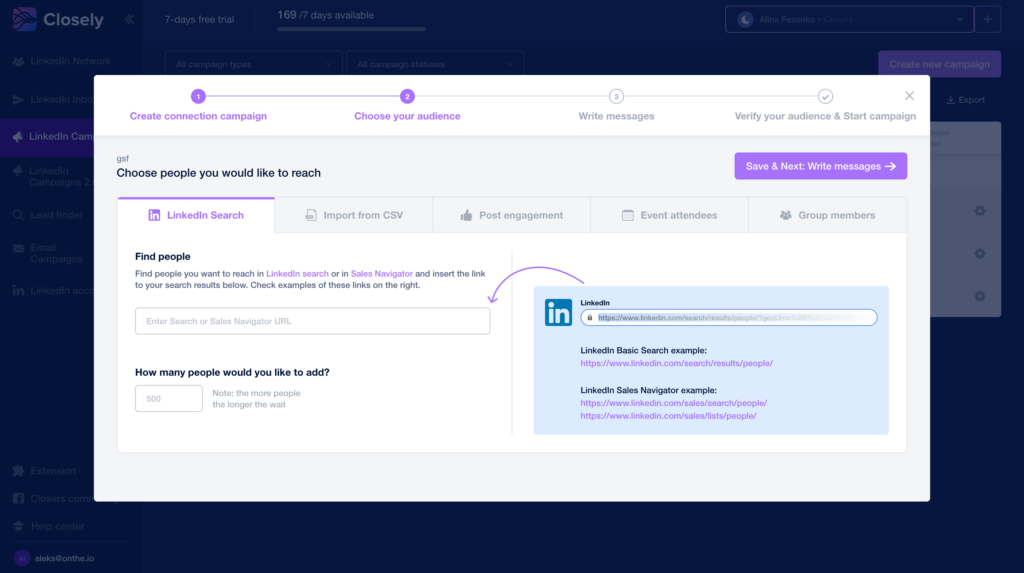
Closely (#1 lead intelligence platform) lets you upload links to LinkedIn groups, events, posts, search results, from which the tool will scrape people (download profiles and build a list). Lead list building is one of the most prominent and crucial steps in LinkedIn prospecting.
Using tools like Closely, you can constantly experiment with targeting, adding new and new audiences to your campaigns.
Start with using LinkedIn filters to find the needed people. Copy the link to your LinkedIn search result and paste it into the field where it’s required.
To find new prospects each time, change the combination of filters on LinkedIn.
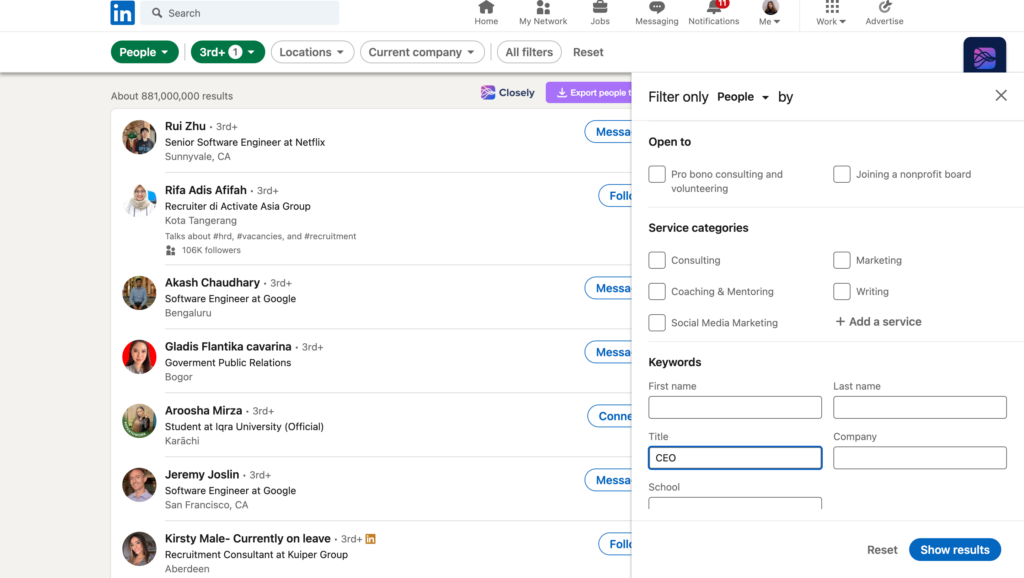
Consider using Sales Navigator (LinkedIn Premium) for expanded filtering options.
Here are also some steps to consider:
- Look up niche groups or events, related to your product or industry.
- Make a list of all the groups on LinkedIn that have something to do with your product/geography/niche/competitors.
- Paste the link to new group from your list when building each new campaign — so Closely can build new lead list for your campaign each time.
- Run new campaign for each new audience.
- Experiment with message sequences. Write the whole new message sequence for each new audience.
Looks like too much on a plate? It only seems so. Because once you’ve created your message sequence, it starts running, automatically generating new hot leads for your demos. In the long run, it turns out, you don’t have anything left for you to do: all manual work is done by Closely.
After a while, your responsibilities come down to just catch leads in your Inbox and entice them, leading to perform the targeted action (jump on a call with you or any other action). All the initial lead generation is run by the automation tool of your choice.
You can also upload a CSV file with your prospects’ LinkedI URLs (if you have one). Just drop it while building your campaign — Closely will grab records from the document and build a list.
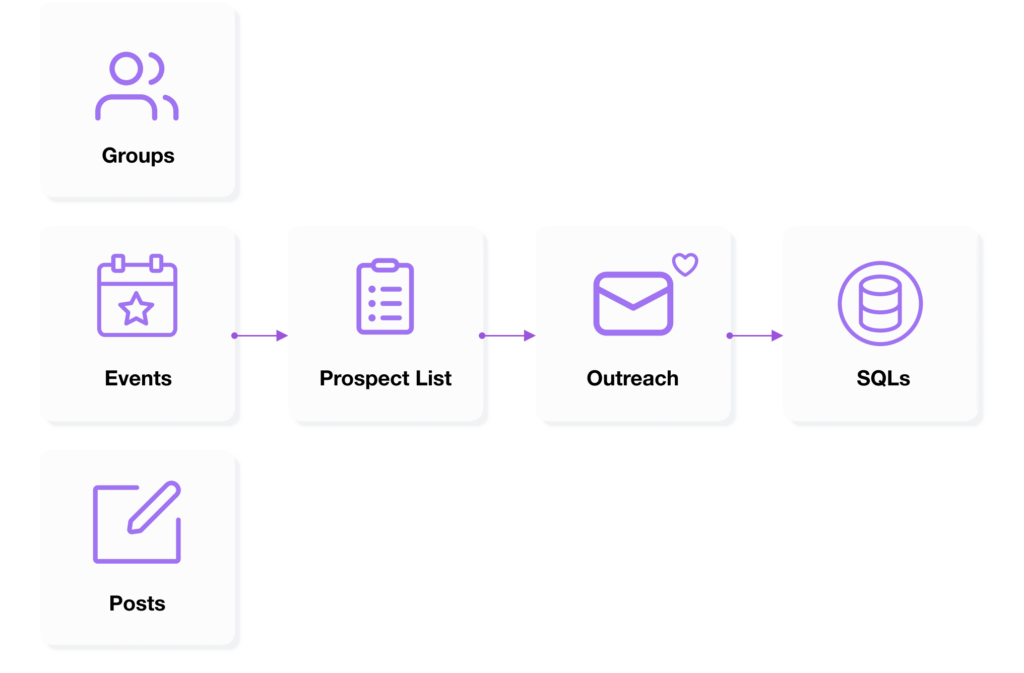
3. Personalization of outreach
Nobody likes to be addressed as “Miss” or “Mister”. It sounds funny.
If you want your campaign to fail for sure — you can start with “Dear sir”.
Automation tools help you craft messages that are personalized and tailored to each recipient in an outreach campaign.
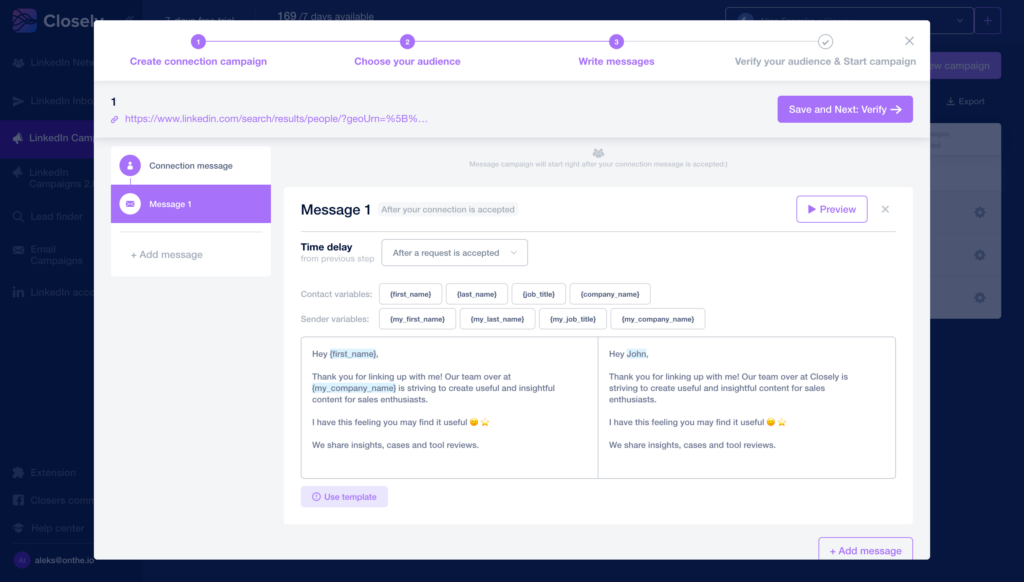
By inserting special variables in your text, you free yourself of another manual job. The tool replaces those variables with contact data from your lead list: first names, last names, job titles, company names, location, and other details. It means that you don’t have to fill this info out manually for each new recipient — just insert a respective variable (like “first name” or “company name”) in your text, and the tool will fill it out with corresponding data from your lead list.
Thus, you’re loaded off and can just sit back and enjoy the automated lead generation.
Personalization is not just about addressing people by their names. It’s also about mentioning their company, job title or industry, which gives more context for them to understand what you want. That’s why there are “company name” variables, “industry” variables, and lots of others.
- Don’t overpersonalize
Salespeople may get carried away, put variables here and there, almost in every sentence, so it sounds like the automation tool they use got broken along the way.
Also,
You cannot use personalization to justify selling your product in the first message. Like this gentleman did.
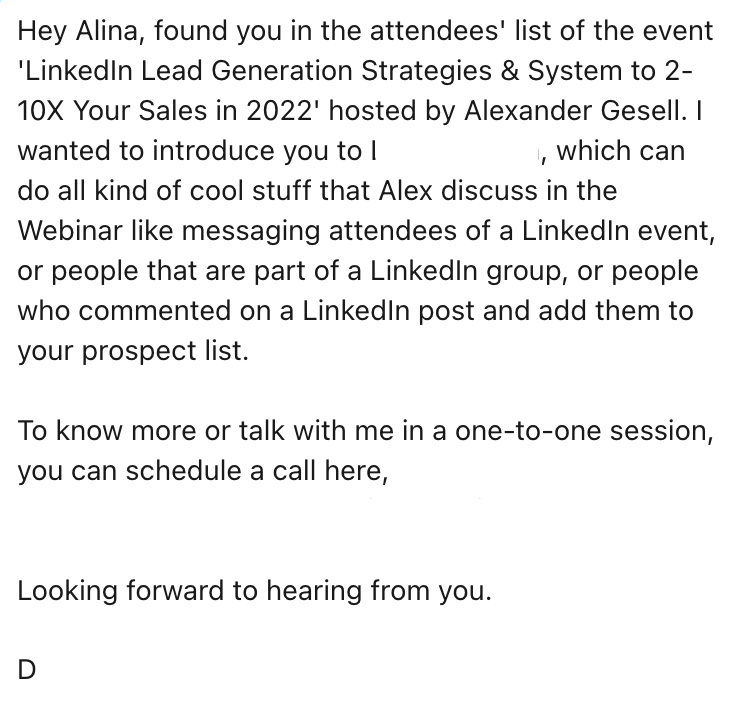
LinkedIn prospecting has its set of rules. The most prominent one is still the same: you can’t push your product in the very first message (if you value your time).
Want to hear a story?
I had a neighbor once — the guy never worked. Normally. He was always after some business ideas, blah-blah.
At times he would sit down at the dining table, look at the ceiling and say, very mysteriously: “I’m all for smart work, not hard“.
I always thought in this case that it’s good if you’re for ANY work actually. Because he didn’t seem to be after any.
The moral of this story is that you can use tricks like personalization or templates, and all the other shortcuts in your work, only if you take them as assistance, and work on your strategies, messaging, targeting, etc, at the same time. It doesn’t work like a magic wand, replacing your creative part of the job. However, if you use it to help you scale — it will accompany along the way greatly. So smart work is good, until there is any work from your end.
Just don’t get lazy))
4. Auto-liking and auto-visiting profiles
Sending connection requests and follow-ups can be a working strategy — however, if you want to scale fast, you may want to try the new and new ways of engaging your prospects.
Today automation tools not only do the LinkedIn messaging, they can actually walk across people’s profiles, like posts, endorse skills and act like it’s you doing all those things.
The only thing you need to do is to build a campaign that consists of additional steps — profile visits, post likes, and skill endorsement.
Watch how it’s done step-by-step in this tutorial.
By auto-liking posts, auto-endorsing skills and auto-visiting profiles, you increase the chances of having your connection requests accepted — people are prone to accept connection requests from those who paid a little bit of attention to their lives (not just intrusively barging into their lives out of nowhere). Basic psychology.
5. Easy way of collecting contact data on LinkedIn
Some automation tools are equipped with very useful add-ons. Like, data scraping extensions.
Instead of manually collecting the needed contact data (emails, phone numbers) of prospects on LinkedIn, opt for a free extension that will rule this routine work with pleasure.
Closely Surfer lets you easily:
- Open prospects’ contact info right on LinkedIn pages
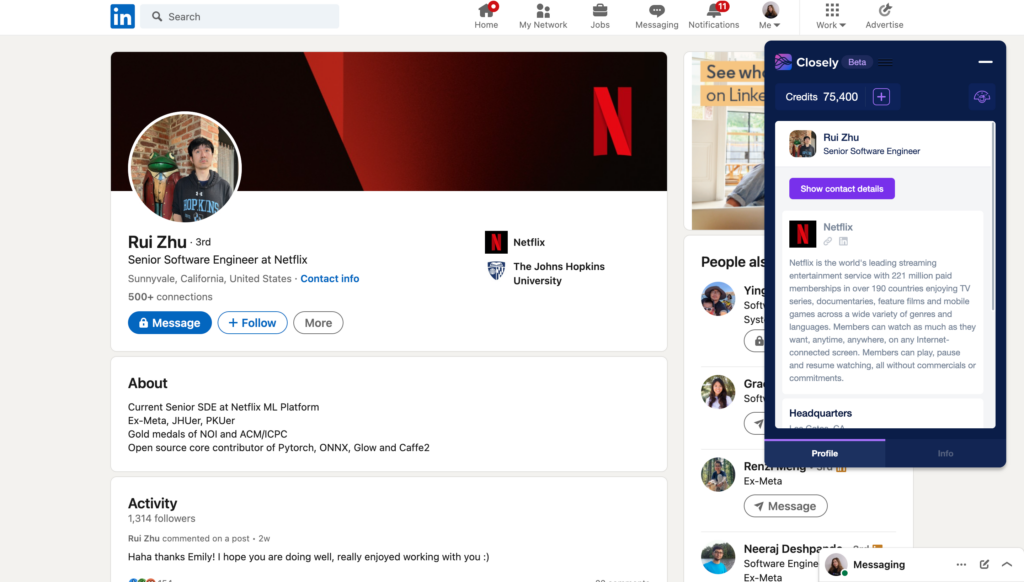
You can reveal such details: phone number, emails, company info.
- Export LinkedIn search results in CSV files (for free).
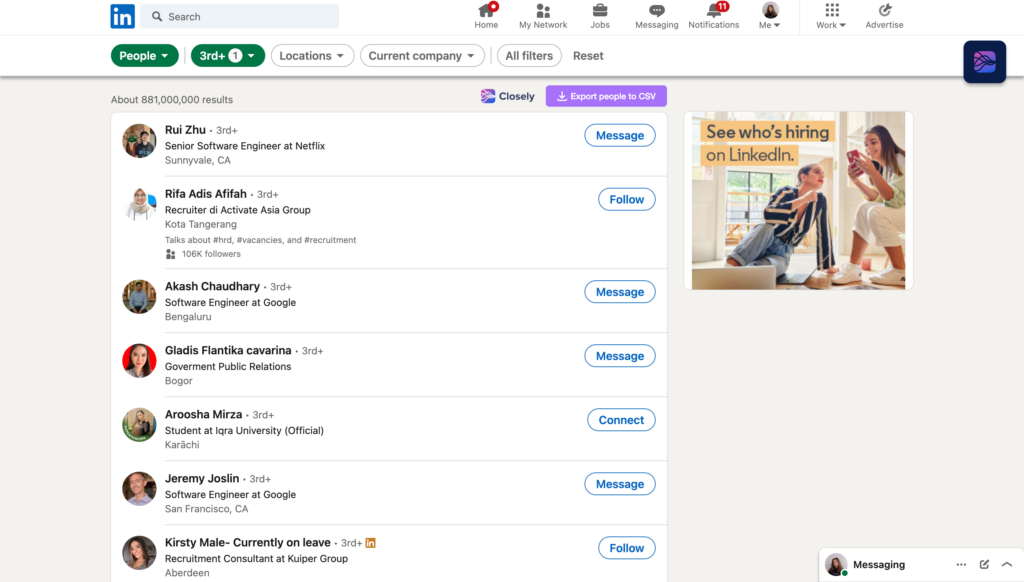
What can you do with this data?
Certainly, you can create and run LinkedIn campaigns by uploading a file with your prospects’ URLs (that you’ve scraped and saved with the help of the extension). You can enrich that file in any data enrichment tool and get your prospects’ emails to launch an email campaign.
If you need to fish up an email of a particular person — just look it up using Closely Surfer. Install the extension once in your browser and exchange your credits for opened contact data.
Once it’s in your browser, it produces buttons right in LinkedIn interface — a convenient way to look up contact info of a prospect the minute you need it, without the need to switch between tabs.
6. Messages to your network
Connection campaigns that you build in automation tools result in:
- Some people accepting your request and replying to any follow-up message in a sequence
- Some people accepting your request but never replying to follow-ups
- Some people ignoring everything that’s happening
- Some people accepting your request and replying to any follow-up message with a firm “no”
The first group is the most lovable — those are people who decided to jump in a conversation with you.

Of course, a large portion of those people from the first group replied because they’re interested in talking to you— here is where you can use Closely Inbox to make your future interactions data-based: you’ll fix down every needed detail to later convert those lucky people into happy customers. We will explain later in tis article how you’ll do that.
For now, we only know that there are also people who accepted your request but ignored the follow-ups (second group). But they’ve slipped into your connections. Now you’re LinkedIn friends. You shouldn’t forget about them, because they’re still people who can turn into leads.
That’s where “Messages to my network” type of a campaign can help.
Messages to my network is a type of campaign that lets you automate LinkedIn messaging for your existing connections. It will send mass messages to your network at scale.
It’s built in the same way as a connection campaign. You can filter your LinkedIn connections the way you like, at the audience building step, and reach out the group of people that you need.
The rest remains the same: just build your campaign, write messages and hit “Launch”.
7. Inbox that is also a CRM

It’s two gifts in one: LinkedIn Inbox that’s also a CRM.
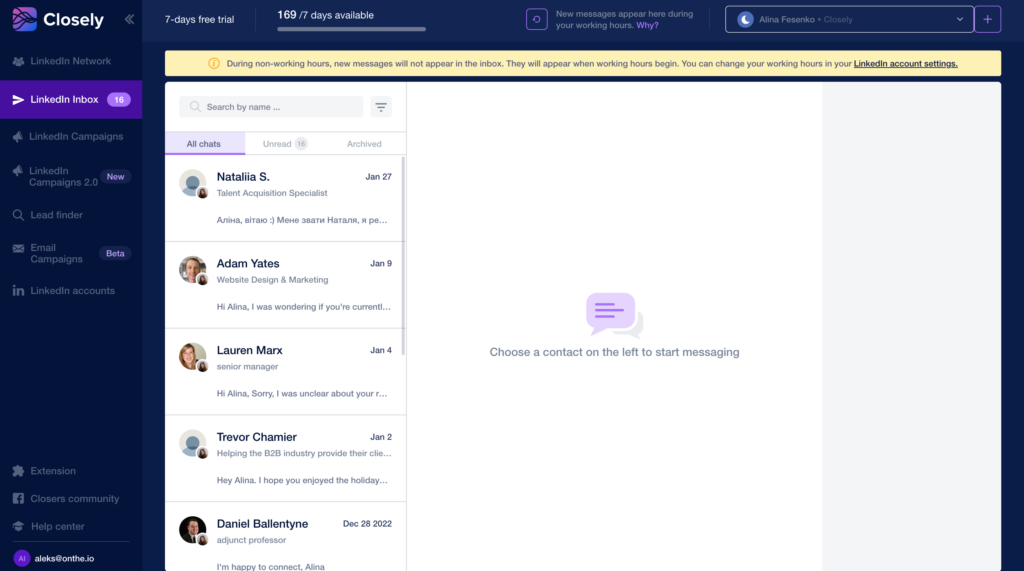
Imagine being able to tag and filter your LinkedIn conversations like in real CRM. That’s what you can do in Closely. Assign tags to your conversations to be able to access the needed one whenever you need it. Add notes to your conversations to be able to recall the needed details -— whenever you need it.
Once you’ve tried it, there is no turning back to regular LinkedIn Inbox.
In this Inbox, you can communicate with your prospects.
8. Best-performing templates for your outreach
When we say “best-performing”, we mean that we’ve packed here all the outreach sequences that brought in any tangible results for us.
Of course, it doesn’t mean it will do the same trick for you. However, if you think about it, you can take any template as an example and flesh it out with the detail of your case. That’s what our customers do. And look how convenient — just filter by the conversion goal and personalization type.
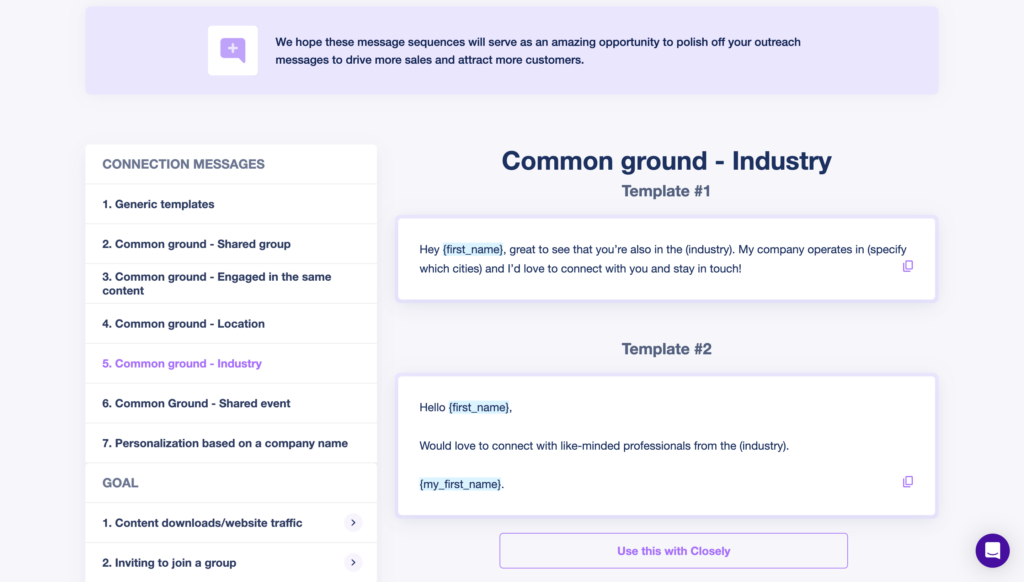
At times, inspiration may leave us… Due to obstacles, blah-blah.
But don’t you worry — these ones are proven messages, so just pick up the one that you like and work on it till you reach perfection (thing they say doesn’t exist).
9. Look at the numbers
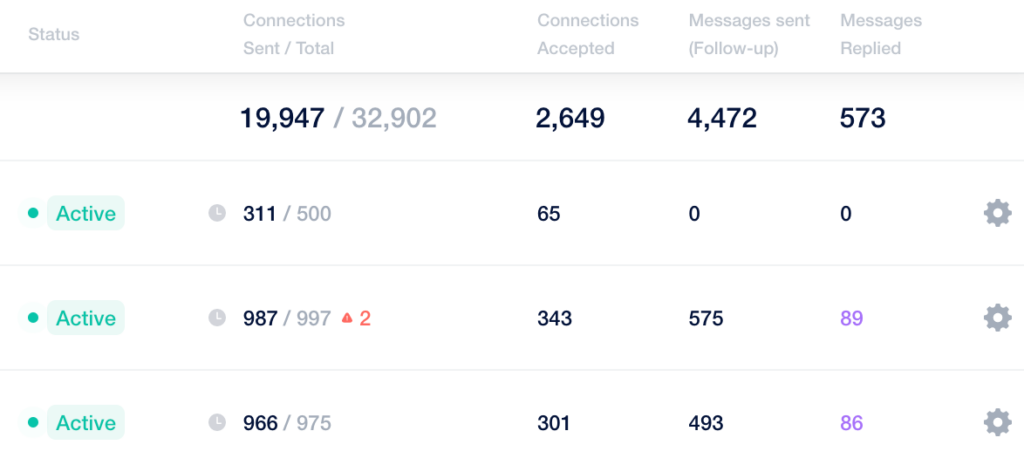
Closely supplies you with enough insights to conclude where you turned wrong in your outreach.
- Connections sent – total number of sent connection requests
- Connections accepted – total number of how many people accepted cr
- How many messages were sent
- How many messages got replies
Once a few campaigns are launched, give it time (ideally a few weeks or even a month). Then the tendency will take shape. You will see which campaign is lagging behind, and will have the chance to analyze what caused its failure.
Then you can try a different message or change the audience — and track whether it worked or not (again).
Ready to move to FAQs?
If you want to learn more about Closely — Maria will give you an overview over a demo call. No pushing and selling (we don’t do that) — don’t hesitate to book a call here.
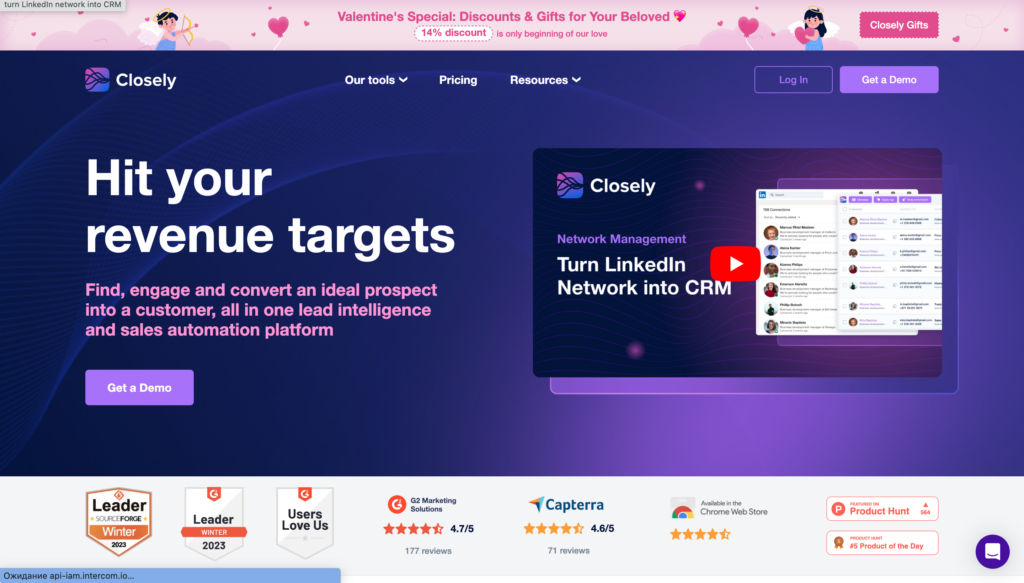
You can see the button on the right side — by clicking on it, you can schedule yourself a call for the most convenient time with this woman.

FAQs
- Is automaton safe?

Yes, it is safe. We use a dedicated IP address and do the same amount of actions a person would do. It’s ensured through the warm-up feature: the tool send a minimum amount of connection requests and message and then gradually increases the amount over time, to mimic human behavior.
- What makes a campaign successful?
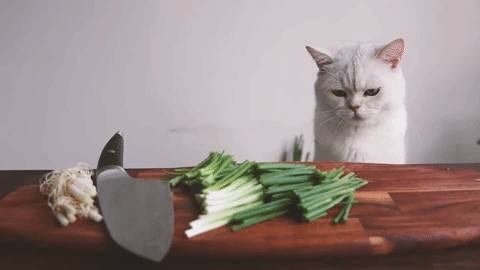
LinkedIn outreach is a never-ending process of experimentation. You run 5,10,50 campaigns, targeting multiples audiences. Then you learned from those that failed. You tweak those that worked for you and duplicate them for another audience. You constantly fine-tune the components of your outreach: targeting, messages, and the general strategy itself.
And of course, be charged up. In natural way. All bad things come to an end — even the failed campaign. If you need inspo or if you have had a bad day, and not feeling like writing a powerful message sequence — use our templates.
- Can Closely automate InMail sending?

No. InMails are not worth investing. It’s too expensive for the results they can bring in. As it seems to us, scaling your outreach with multiple campaigns, running from different LinkedIn accounts of your team members — is a cheaper and more effective way, imho.
Thanks for coming by. Now you know how to automate your LinkedIn outreach in a smart and pleasant way.
Happy prospecting! 🌸
